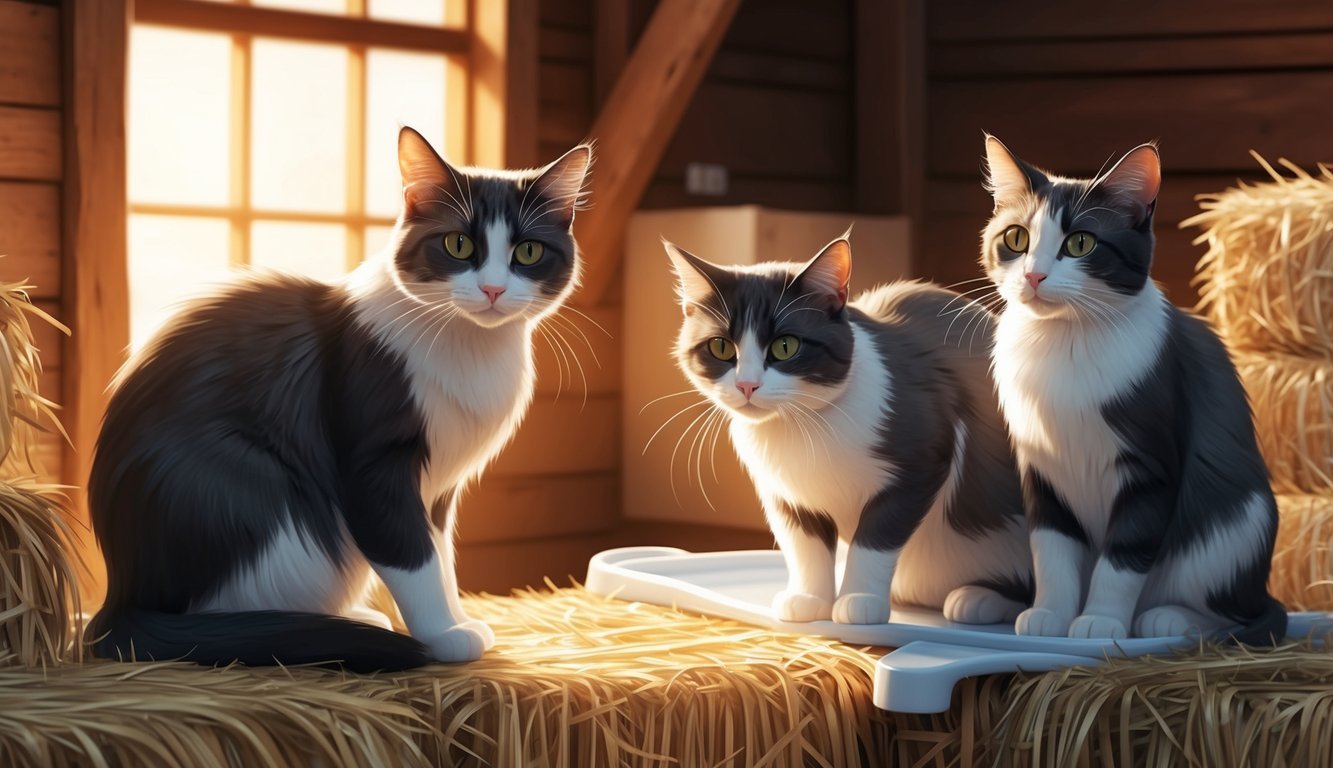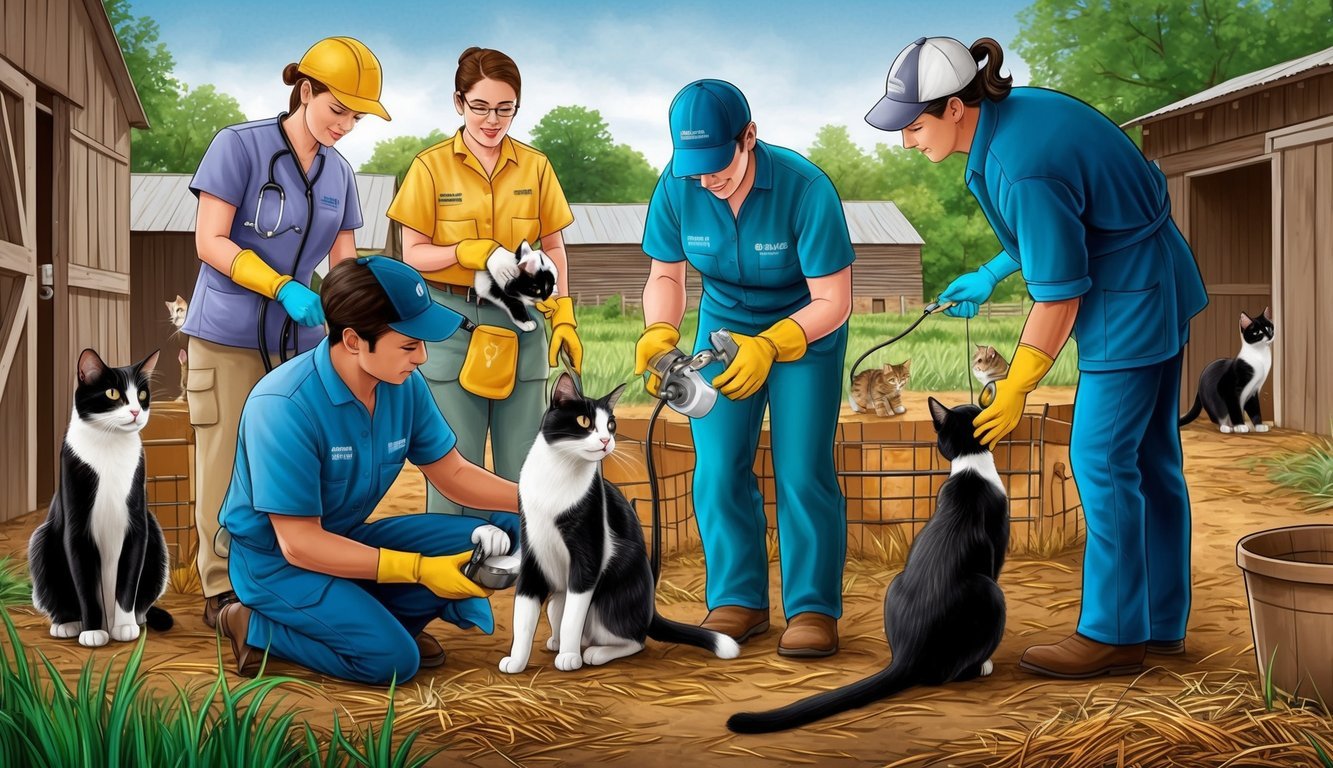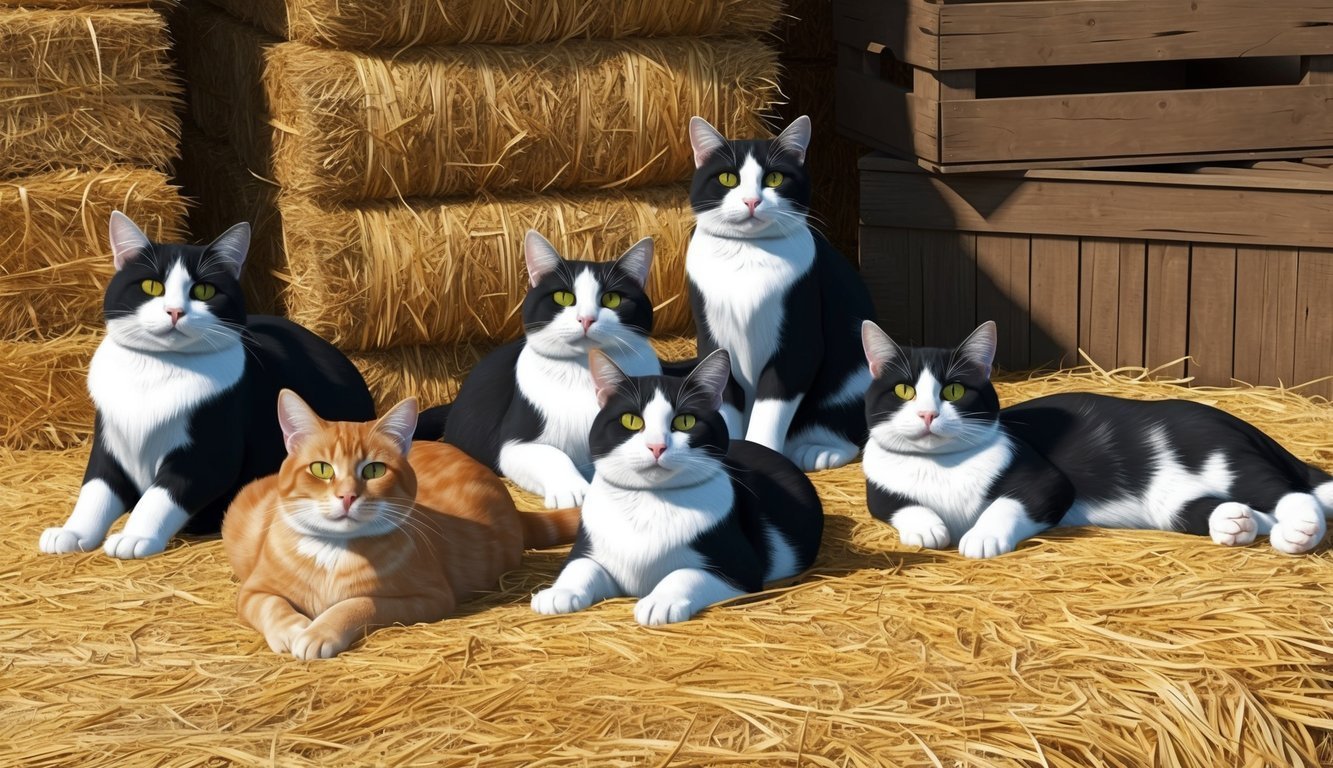Barn cats are more than just animals that roam the fields.
They play a vital role in controlling rodent populations and maintaining the health of your agricultural space. Understanding the unique needs and behaviors of barn cats can help you create a harmonious environment for both your feline friends and your farm.
These hard-working cats, often either domestic or feral, thrive in outdoor settings and make excellent companions that can form a bond with you and your property.
Choosing the right barn cat involves considering various factors, such as their health, care requirements, and how to effectively introduce them to their new surroundings.
From adopting working cats that are unsuitable as house pets to providing them with the veterinary care they need, there’s a lot to know about ensuring they live healthy and fulfilled lives.
Once properly acclimated, these independent creatures can provide effective pest control and companionship on your farm, making them invaluable partners in agricultural settings.
In this blog post, you’ll explore key aspects of barn cats, including their care, adoption, and management, while also addressing common questions about these unique animals.
Understanding how to care for barn cats not only promotes their welfare but also enhances the functionality of your farm.
Key Takeaways
- Barn cats effectively control rodent populations in agricultural settings.
- Proper care and acclimation are essential for a healthy barn cat.
- Adopting barn cats can benefit both the animals and your farm’s ecosystem.
The Role of Barn Cats
Barn cats play a significant role on farms and rural properties.
They contribute to pest control while also thriving in their semi-feral lifestyles, providing companionship and character to agricultural settings.
Natural Rodent Control
One of the primary roles of barn cats is their effectiveness in rodent control.
With keen hunting instincts, these cats naturally seek out vermin such as mice and rats that threaten crops and food supplies.
Their presence alone can deter pests due to their natural predatory behavior.
Feral farm cats often hunt at dawn and dusk, aligning their activity with the habits of their prey.
You may notice a reduction in rodent populations fairly quickly after introducing barn cats to your property.
Their ability to adapt to various environments further enhances their success in managing pest issues.
Barn Cat Behaviors
Understanding the behavior of barn cats can help you appreciate their role on the farm.
These cats exhibit semi-feral tendencies, often balancing between wild instincts and interactions with humans.
They can establish their territories in barns or shelters, where they feel secure.
Barn cats are generally solitary hunters but may socialize in a loose hierarchy.
You might find them lounging in sunlit spots or climbing on hay bales, showcasing their playful nature.
Regular feeding and care can lead to stronger bonds if you decide to interact with them, making them valuable companions beyond their pest control abilities.
Benefits to Farms and Shelters
The presence of barn cats can bring various benefits to both farms and shelters.
For farms, these cats provide a natural solution to pest problems.
By controlling rodent populations, they help maintain healthier crops and livestock.
This environmentally friendly approach reduces the need for chemical pest control methods.
As for shelters, barn cat programs offer a second chance for feral cats.
Many organizations, like The Humane Society, implement these programs to find homes for cats that are less suited for indoor living.
By adopting these cats, you not only help them thrive but also benefit your farming operation through their hunting prowess.
Supporting such initiatives fosters a harmonious relationship between agriculture and animal welfare.
Understanding Barn Cats
Barn cats play a unique role in farm environments.
They help control rodent populations while providing companionship.
To fully appreciate them, it’s essential to understand the distinctions between different types of cats, the breeds commonly found in barns, and their temperament.
Differences Between Feral, Stray, and Domestic Cats
Feral cats are those that live in the wild.
They have little to no human interaction and can be wary of people.
Stray cats, on the other hand, once lived with humans but are now alone.
They might be more sociable and approachable than feral cats.
Domestic cats are bred to coexist with humans.
They thrive in social settings and can develop strong bonds with their owners.
Understanding this difference helps you approach barn cats correctly.
The Various Breeds of Barn Cats
While you may encounter mixed-breed barn cats, certain breeds are also common in these roles.
- Maine Coon: Known for their size and friendly nature, these cats are excellent pest controllers.
- Siamese: These cats are social and vocal, often forming strong attachments to humans.
- American Wirehair: With their unique coat, they’re adaptable and can handle various environments.
Mixed breeds often exhibit a blend of traits from different breeds, making them versatile companions.
Temperament and Socialization
Barn cats typically need proper socialization to thrive.
While some may be shy initially, regular interaction can help them adjust.
They often exhibit a range of behaviors and personalities, from playful to stoic.
Many barn cats become affectionate if treated well.
You may find them following you around or sitting nearby while you work.
However, respecting their space is crucial, especially if a cat shows signs of being feral or fearful.
Each cat is unique, and patience goes a long way in nurturing their social skills.
Health and Veterinary Care

Caring for barn cats involves addressing their health needs through routine veterinary care.
Proper attention to vaccinations, spaying or neutering, and monitoring for common health issues is essential for keeping your barn cats healthy and happy.
Importance of Vaccinations and Spaying/Neutering
Vaccinations are critical for protecting your barn cats from preventable diseases.
Core vaccines, such as those for rabies and feline distemper, help ensure their long-term health.
Talk with your veterinarian about a proper vaccination schedule suited to your cats’ lifestyle and risks.
Spaying or neutering your barn cats is equally important.
This prevents unwanted litters and helps reduce roaming behaviors.
Cats that are spayed or neutered often have fewer behavioral issues and can lead healthier lives, minimizing the risk of certain cancers and infections.
Common Health Issues
Barn cats face unique health challenges, often exposed to various risks in outdoor environments.
Common issues include respiratory infections, parasites, and injuries.
Keep an eye out for symptoms like coughing, sneezing, or lethargy, as these may indicate health problems.
Parasites such as fleas, ticks, and worms can also affect barn cats.
Regular deworming and flea prevention strategies help manage these issues effectively.
Create a checklist to monitor your cats’ health for signs of infestation.
Additionally, outdoor cats are at risk of injuries from fights with other animals or accidents.
Regularly inspect your cats for wounds or signs of distress, and consult a veterinarian if you notice anything unusual.
Routine Veterinary Visits
Establish a routine veterinary visit schedule to monitor the health of your barn cats.
Regular check-ups are essential for early detection and treatment of health issues.
During these visits, your vet will assess overall health, recommend vaccinations, and provide advice on parasite prevention.
Don’t skip these visits just because your cats appear healthy.
Many conditions can be silent until they become serious.
Keeping your barn cat’s health in check means scheduling these visits at least once a year, or more frequently if your cat has specific health concerns.
Barn Cat Adoption and Acclimation
Adopting a barn cat can provide immense benefits for managing pests while also giving a cat a new chance at life.
To ensure a smooth transition for your new feline, it’s essential to choose the right cat and create a nurturing environment.
Choosing the Right Barn Cat
When selecting a barn cat, look for cats that are from a barn cat network or a shelter specifically focused on outdoor life.
These cats are generally more suited to the environment and accustomed to less human interaction compared to indoor cats.
Consider their socialization level; some might be shy while others are more confident.
Key factors include:
- Temperament: Opt for a cat that demonstrates curiosity and resilience.
- Health Status: Ensure they are spayed/neutered, vaccinated, and healthy to minimize health issues later.
- Familiarity with Environment: Look for cats that have prior experience in similar outdoor settings.
Acclimation Process
Acclimating your new barn cat is critical for helping them adjust.
This period usually lasts 2 to 4 weeks.
During this time, confine the cat in an escape-proof area, such as a barn or small shed.
Include necessities like:
- Food and water
- A litter box
- A comfortable sleeping area
This confinement allows the cat to learn the sounds, smells, and routines of their new home, reinforcing that this is now their safe space.
Be patient; every cat acclimates at their own pace.
Creating a Welcoming Environment
To help your barn cat settle in, create an environment that encourages exploration and comfort.
Start by ensuring the area is safe, free from hazards like poisons or dangerous plants.
Additional considerations:
- Shelters and Hiding Spots: Provide sheltered areas where the cat can retreat and feel secure.
- Feeding Stations: Place food and water in consistent, quiet locations to avoid stressing the cat.
- Routine: Establish a feeding and care routine to build trust and predictability.
By fulfilling these needs, you set the foundation for a successful barn cat adoption and a harmonious relationship.
Population Management

Effective population management is essential for maintaining a healthy environment for barn cats.
It ensures that their numbers remain sustainable and prevents health issues related to overpopulation.
Here are key aspects to consider.
Tackling Overpopulation
Overpopulation is a significant challenge for barn cat communities.
When numbers increase uncontrollably, it can lead to resource depletion and health problems.
Key strategies include:
- Spaying and Neutering: This is perhaps the most effective way to manage cat populations. It significantly reduces unwanted litters and the associated issues.
- Regular Monitoring: Keeping track of cat numbers helps identify trends and take action before issues arise.
- Feeding and Care: Consistent feeding routines encourage barn owners to regularly observe and engage with their cats, which aids in early identification of health issues.
Barn Cat Networks and Community Support
Community involvement is vital in managing barn cat populations.
Forming networks can enhance the effectiveness of population control efforts.
Consider these aspects:
- Local Organizations: Joining or creating a barn cat network connects you with resources and experienced individuals.
- Community Education: Informing your community about the importance of spaying and neutering fosters better practices.
- Trap-Neuter-Return (TNR) Programs: These initiatives allow volunteers to humanely trap feral cats, spay or neuter them, and then return them to their original location, effectively managing population without harm.
Success Stories of Barn Cat Integration
Many farms have successfully integrated barn cats into their operations while maintaining a balanced population.
Examples include:
- Adopting TNR Practices: Farms that implement TNR see reduced cat populations over time and fewer issues related to health and behavior.
- Community Collaboration: Partnering with local animal welfare organizations often results in more efficient population management.
- Public Awareness Campaigns: Sharing success stories within the community can inspire others to adopt similar practices, leading to a broader impact on managing feral and community cat populations.
Feeding and Care
Taking care of barn cats involves meeting their nutritional needs, providing appropriate shelter, and ensuring their long-term health.
Let’s explore each aspect to keep your feline companions happy and healthy.
Nutritional Needs of Barn Cats
When feeding barn cats, you need to provide a balanced diet that meets their unique needs.
Make sure to offer high-quality cat food with both dry and wet options.
Dry food should contain a good portion of protein, while canned food helps increase hydration.
You should feed them twice a day to maintain energy levels.
It’s also crucial to monitor their food intake to prevent weight issues.
Adjust the portions based on their activity level; more active cats will require more energy.
Make sure that food is stored securely to prevent outside animals from accessing it.
Keeping a consistent feeding schedule will help keep your cats healthy and well-nourished.
Shelter and Safety
Shelter is a cornerstone of barn cat care.
Your cats need a safe, warm, and dry place to retreat.
A well-constructed cat house or shelter can significantly improve their living conditions.
Ensure there are enough resting spots to accommodate several cats, especially during harsh weather.
Use insulated materials to protect against cold and wet conditions.
You should also place the shelter away from high-traffic areas to provide a sense of security.
Regularly check for any hazards around the barn that might pose risks, such as toxic plants or sharp objects.
Creating a safe environment allows your barn cats to thrive.
Long-Term Care and Considerations
Long-term care for barn cats involves regular veterinary check-ups.
Make sure to spay or neuter them to control the population and prevent related health issues.
Vaccinations and flea treatments are also essential for their health.
Maintain a consistent feeding schedule, but be prepared to adjust food types based on their aging.
Older cats may require specialized diets.
Lastly, monitor their behavior and health regularly.
Any changes in appetite, weight, or activity level can signal health issues.
Encouraging a self-sustaining lifestyle, such as hunting rodents, is beneficial, but always provide supplementary food to ensure their nutritional needs are met.
Frequently Asked Questions
You might have some questions about barn cats and how they fit into your property.
Understanding their care, benefits, and integration can help ensure a smooth experience for you and your new furry companions.
How do I find barn cats available for adoption?
To find barn cats for adoption, reach out to local feral cat rescue groups, TNR (Trap-Neuter-Return) organizations, or animal shelters.
Many of these places are dedicated to rehoming cats that may not adapt to indoor life but can thrive outdoors.
What’s the best way to prevent my new barn cat from running away?
To keep your new barn cat from running away, start by keeping them indoors for a couple of weeks.
This allows them to acclimate to their new environment.
Afterward, gradually introduce them to outdoor spaces while ensuring a safe area, so they feel secure.
Can you suggest effective methods for introducing barn cats to one another?
When introducing barn cats, begin with a slow introduction.
Keep them in separate spaces and allow them to get used to each other’s scent.
After a few days, let them see each other without direct contact, gradually increasing their interactions, while monitoring their behavior.
What are the benefits of having barn cats on my property?
Barn cats are excellent for natural rodent control, which helps protect your property and crops.
They can also reduce the need for chemical pest control methods, promoting a more eco-friendly environment.
Plus, they can be great companions while working on the farm.
How does a barn cat differ from a feral cat?
Barn cats are typically feral but are often more socialized to humans and can adapt well to life in a barn setting.
Feral cats usually avoid human interaction and are less likely to thrive in domestic environments.
Barn cats are often placed in working situations where they receive care and food.
What should I consider when deciding on the number of barn cats for my farm?
When deciding on the number of barn cats, you should consider the size of your property and the level of rodent activity.
A general rule is one to three cats per acre, depending on the environment.
You should also think about the resources you can provide for their care.


